by Victoria La Barre
I am a 2015 Waco High School graduate and Greater Waco Advanced Manufacturing Academy (GWAMA) alumna. GWAMA is a regional magnet program that provides classes in Welding, Robotics, and Precision Metal Manufacturing. Eleven surrounding school districts participate in the program. From my personal experience, GWAMA provides an amazing opportunity that opens many doors. As a member of the Robotics Academy, I worked through a rigorous curriculum that included electronics and robotics, multiple robotics competitions, and learning 3D printing software. I currently volunteer in the program as a mentor, tutor and instructional assistant.
GWAMA provides instruction that is geared toward hands-on learning styles which are more project-based rather than the regular old pencil, paper, and textbook approach. My senior project was the design and production of a 9-foot animatronic crocodile for Waco High’s production of Tarzan: The Disney Musical, which could snap its jaws and drive through the crowd during intermission.
After graduation, because of the hands on training and experience I received at GWAMA, I was immediately offered jobs at TSquared, Capstone Mechanical, Trane, Sonoco and VanTran. While most people my age were flipping burgers, I spent my summer working in the technical field participating in the manufacturing of high-powered transformers. This allowed me to see firsthand how members of a company team up to take an engineer’s blueprint and turn it into an actual working product. This summer job was a truly electrifying experience.
In my case, the open doors, didn’t stop there! Because of my experience working in 3D printing software, my first semester as a student at McLennan Community College, I was able to design and print a prosthetic leg for Bruno, a dog at the Humane Society. This project, and my previous experience with robotics at GWAMA, also positioned me for acceptance into the Mars Society as a member of crew 167B. This April, the Mars Society will take me and my Mars rover research project through an intensive Mars simulation in the desolate deserts of Utah. I have also been accepted as a NASA Community College Aerospace Scholar, and if my application is accepted, I plan to intern at SpaceX this summer.
 GWAMA isn’t only a fantastic program that helps jumpstart its students’ futures, but this program also has recently begun expanding its reach into the community. This past December, the Welding Academy created Star Wars inspired metal sculptures that were on public display at the Hippodrome while Star Wars: The Force Awakens showed at the theatre. GWAMA’s welders and members of the Precision Metal Manufacturing Academy also worked their magic to create the carriage for the musical production of Cinderella at University High School, and developed moveable props for the UHS Mighty Trojan Marching Band’s UIL show.
GWAMA isn’t only a fantastic program that helps jumpstart its students’ futures, but this program also has recently begun expanding its reach into the community. This past December, the Welding Academy created Star Wars inspired metal sculptures that were on public display at the Hippodrome while Star Wars: The Force Awakens showed at the theatre. GWAMA’s welders and members of the Precision Metal Manufacturing Academy also worked their magic to create the carriage for the musical production of Cinderella at University High School, and developed moveable props for the UHS Mighty Trojan Marching Band’s UIL show.
On the other side of the building, the Robotics Academy has introduced STEM (Science, Technology, Engineering and Math) to the next generation by mentoring a Lego-League robotics class in Indian Spring Middle School’s after school program. For older students interested in technology, high school girls are always welcome to join the Metallic Clouds, a Girl Scouts sponsored FIRST Robotics Competition team housed at GWAMA. (Contact Joe Rizo, Lead Robotics Mentor, at 512-787-3935 or at [email protected] for more information).
Perhaps the best part of GWAMA’s curriculum is its strong support of its students’ learning. No matter what kind of technology any student is interested in, be it welding, robotics, precision metal, or rocketry, GWAMA offers all its students after-school tutoring – even on Saturdays! GWAMA also highly encourages their students to participate in highly regarded competitions, such as BEST, VEX, FRC, FTC and SkillsUSA in order to buff up students’ resumes. Speaking of resumes, students receive one-on-one interview help and resume editing assistance in preparation for the annual career fair, where students have the opportunity to meet local employers in their respective fields.
All in all, GWAMA has provided a great opportunity for me and several other students from the local region to develop a skill set that prepares us for success in the workplace, and I’m sure the program will continue to inspire its students in the future. I encourage any high schooler to seriously consider joining this program, where the sky is not the limit – it’s the goal!
 Victoria La Barre loves robotics and has been on many teams. (BEST, VEX, FRC, FTC and Skills USA) She now mentors a Lego-League robotics team at Indian Springs middle school during their after-school program. She currently pursuing an electrical engineering associates degree at McLennan Community College and plans on either transferring to Texas A&M or Texas Tech University to continue a Masters degree. For more information about GWAMA, including information about how to apply, please visit the website: http://gwama.wacoisd.org/home/
Victoria La Barre loves robotics and has been on many teams. (BEST, VEX, FRC, FTC and Skills USA) She now mentors a Lego-League robotics team at Indian Springs middle school during their after-school program. She currently pursuing an electrical engineering associates degree at McLennan Community College and plans on either transferring to Texas A&M or Texas Tech University to continue a Masters degree. For more information about GWAMA, including information about how to apply, please visit the website: http://gwama.wacoisd.org/home/
The Act Locally Waco blog publishes posts with a connection to these Aspirations for Waco. If you are interested in writing for the Act Locally Waco Blog, please email [email protected] for more information.
by Saul Cornejo Bravo
Throughout history there have been many times when the youth, frustrated by issues affecting society, have rallied together to invoke change in our nation. In previous decades, those issues included civil rights, education, the Vietnam War, and free speech. What made the movements of these past generations successful was hope that change could be enacted and a willingness to use the collective power people hold in our democracy to achieve it. In contrast, our generation, the millennials, are currently described as too lazy, sensitive, safe-space-confined, selfie-obsessed, and self-absorbed to care about anything going on in the world. If judged by voting percentages of 18 to 29 year olds, that assertion might be correct. Millennials’ voting participation rate peaked in 2008, when 51% of the eligible voters from the youngest voting block participated that presidential election year. In contrast, during the last midterm election only about 21% voted. Because of this, politicians have had little incentive to act in our generation’s best interest. In particular, there is an urgent issue that I, along with the other members of the MCC Up to Us team, believe must be addressed because of its impact on our generation: the national debt. This debt issue threatens the future prosperity of our country and the future livelihood of young Americans through its effect on taxes, and federal spending.
The Up to Us team at McLennan College is running a national debt awareness campaign, as part of a national competition, in the hope that we can inform our peers about the issue and inspire them to take action by participating in the political process. Our campaign is non-partisan; we aren’t endorsing any political ideology, party, candidate, or even legislation. Instead, we believe this issue should transcend party lines and ideologies because Democrats and Republicans alike have gotten us to this point, and everyone will be affected by it, whether they consider themselves liberals or conservatives. Additionally, we do not want to promote intergenerational conflict, but we believe that our current political leaders, in regard to the national debt, are making decisions hurting our generations’ best interest, because the debt accumulated today will affect society tomorrow. Our main goal is to make our peers aware of the national debt and the importance of government fiscal responsibility, because our federal budget, apart from showing how we allocate our resources, demonstrates where our values and priorities lie.
After years of continued borrowing from the prosperity of future generations by running high federal budget deficits, the national debt is close to 19 trillion dollars. This debt accumulation trend, if left unaltered, could have negative consequences for our country. For example, in 2015 we spent approximately $224 billion in interest, more than we spend on education, research and development, and infrastructure– which are investments for our future– combined. Additionally, our annual interest payment is expected to more than double to $772 billion by 2025. Therefore, we must consider our priorities when thinking about increasing the national debt because we can’t fund the government through deficits indefinitely.
Currently, major drivers of the national debt are the national healthcare programs, but sadly there has been little done to make them sustainable. Over 40%, or about 1.8 trillion dollars, of our federal budget goes towards social health programs like Medicare, Social Security, and Medicaid, with costs growing every year. For example, due to the baby boomer generation retiring, Social Security and Medicare, in particular, have become extremely costly and are unsustainable under current law. In 1960, the worker to beneficiary ratio was 5 to 1. In 2009 it reached 3 to 1, and by 2035 it’s projected to reach 2 to 1, which will make Social Security an even bigger burden on our budget. Granted, these programs are important for our society, but if we want to continue having them, we need to make them sustainable in a way that won’t sacrifice the future of our country.
Our current political leaders are heavily divided among political parties and ideologies, and are unwilling to solve the issue. This led to a government shutdown in 2013 and inaction to reduce our budget deficits. Additionally, politicians from both sides of the aisle continue to irresponsibly propose plans that could have a significant negative effect on our deficit, such as heavily increasing spending or cutting taxes, the government’s revenue, by trillions. Proposals like this borrow from the prosperity of future generations for immediate political benefits. Therefore, it is up to millennials, the generation that in the future will suffer the consequences of the decisions made today, to demand action and hold our politicians accountable by participating in the voting process. By joining together now, we can cement our legacy as the generation that ensured America’s prosperity by demanding fiscal responsibility and ensuring our resources are spent investing in our future.
Follow the McLennan College Up to US campaign on Instagram @MCCUotoUs to learn more about the national debt and follow their campaign.
 Saul Cornejo Bravo is a student at McLennan Community College and currently interns at First Friday Waco. He is passionate about community development and plans to transfer to UT Austin and major in Economics.
Saul Cornejo Bravo is a student at McLennan Community College and currently interns at First Friday Waco. He is passionate about community development and plans to transfer to UT Austin and major in Economics.
The Act Locally Waco blog publishes posts with a connection to these Aspirations for Waco. If you are interested in writing for the Act Locally Waco Blog, please email [email protected] for more information.
Notes:
https://www.ssa.gov/history/ratios.html
https://www.ssa.gov/oact/trsum/
https://www.cbo.gov/topics/budget/long-term-budget-analysis
by Jenuine Poetess
 I recently purchased a couple of plain end tables to use in my new office. I got them for a great (read: cheap) price at a local discount home goods store but they lacked a certain…something. As I was looking at them, the thought occurred to me, “These would look awesome with mosaic tops.” My second thought was how daunting it might be to try to find all the supplies to accomplish my creative goal myself. Happily, my third thought was, “I wonder if I could take these to Practically Pikasso and mosaic them there?” So I called, and they said, “Sure, come on over!”
I recently purchased a couple of plain end tables to use in my new office. I got them for a great (read: cheap) price at a local discount home goods store but they lacked a certain…something. As I was looking at them, the thought occurred to me, “These would look awesome with mosaic tops.” My second thought was how daunting it might be to try to find all the supplies to accomplish my creative goal myself. Happily, my third thought was, “I wonder if I could take these to Practically Pikasso and mosaic them there?” So I called, and they said, “Sure, come on over!”
I was thrilled! For a mere $6.00 studio fee I began my project to turn these somewhat drab tables into something delightful.
 Before I continue, let me rewind and share a little back story. Practically Pikasso is, “an eclectic art studio” located in the shopping plaza at the intersection of Waco Drive and New Road. I have been there a few times before to paint pottery—which is one of their main offerings: a grand array of blank, white, ceramics in so many shapes and sizes ready for color and design. Their selection ranges from practical dishware, to specialty holiday décor, to character figurines, and intricate sculptures. There is no need to have any prior art experience, the knowledgeable and patient staff at Practically Pikasso will provide all the instructions, recommendations, and guidance needed to create your masterpiece! There is a vibrant array of ceramic glazes from which to choose including textured/flecked, smooth, and glass glazes in a rainbow of hues.
Before I continue, let me rewind and share a little back story. Practically Pikasso is, “an eclectic art studio” located in the shopping plaza at the intersection of Waco Drive and New Road. I have been there a few times before to paint pottery—which is one of their main offerings: a grand array of blank, white, ceramics in so many shapes and sizes ready for color and design. Their selection ranges from practical dishware, to specialty holiday décor, to character figurines, and intricate sculptures. There is no need to have any prior art experience, the knowledgeable and patient staff at Practically Pikasso will provide all the instructions, recommendations, and guidance needed to create your masterpiece! There is a vibrant array of ceramic glazes from which to choose including textured/flecked, smooth, and glass glazes in a rainbow of hues.
My mosaic project was divided into two segments over two days. Step one was to select my materials and create my desired design. There was a wide selection of materials to choose from including ceramic tiles of various shapes and sizes, glass beads, stained glass pieces, glass tiles, and mirror pieces. Once I determined my design—which took some time on my part to make sure that all the materials I was using would go together, had the same thickness so my finished table tops would be smooth and flat, and fit my design—then I needed to secure all the pieces onto my table top which I did with regular white craft glue (which dries clear). I also needed to be sure I left little channels between all my pieces where the grout would go in the second half of my project. The staff on duty during my first phase was helpful and patient with all my questions; he gave me excellent direction and assistance.
 I was excited to find the stained glass pieces among my options for mosaic. I have a special fondness for glass art as my grandmother was a stained glass artist. I also love how the pieces were swirled with a bit of white which yielded a lovely ocean and sky feel to me. I selected iridescent blue glass tiles for the outer border and then alternated iridescent glass with streaked stained glass in concentric squares. I was definitely channeling a beach vibe! With that, phase one was complete and I took the tables home to dry overnight.
I was excited to find the stained glass pieces among my options for mosaic. I have a special fondness for glass art as my grandmother was a stained glass artist. I also love how the pieces were swirled with a bit of white which yielded a lovely ocean and sky feel to me. I selected iridescent blue glass tiles for the outer border and then alternated iridescent glass with streaked stained glass in concentric squares. I was definitely channeling a beach vibe! With that, phase one was complete and I took the tables home to dry overnight.
 In addition to the pre-made ceramics to paint, Practically Pikasso also offers glass fusing, mosaic, and hand thrown pottery projects and classes. This unique art space is the perfect place to unwind after a stressful day, catch up with friends, enjoy a date night out, or relish some adult/child bonding time for parents, mentors, and relatives alike! No reservations are needed for individuals and small groups (2-4 people) but larger parties may want to call ahead to be sure there is enough space. Large groups may also reserve the special party space for after work art happy hours, birthdays, parties, showers, and other special occasions. Practically Pikasso hosts a number of group events such as Girl & Boy Scout troops, School art classes, Greek gatherings, Corporate Team Building/Staff Retreats and more—groups may reserve a spot on location or Practically Pikasso will come to you!
In addition to the pre-made ceramics to paint, Practically Pikasso also offers glass fusing, mosaic, and hand thrown pottery projects and classes. This unique art space is the perfect place to unwind after a stressful day, catch up with friends, enjoy a date night out, or relish some adult/child bonding time for parents, mentors, and relatives alike! No reservations are needed for individuals and small groups (2-4 people) but larger parties may want to call ahead to be sure there is enough space. Large groups may also reserve the special party space for after work art happy hours, birthdays, parties, showers, and other special occasions. Practically Pikasso hosts a number of group events such as Girl & Boy Scout troops, School art classes, Greek gatherings, Corporate Team Building/Staff Retreats and more—groups may reserve a spot on location or Practically Pikasso will come to you!
 I was able to complete phase 2 of my project the next day after work. I brought my tables back to finish them with grout. I was able to choose from white, black, or grey grout. I went with the white to bring out the bright blues and mimic an island beach look. While I was grouting, I had the pleasure of meeting the owners, Marie and Russ. They hadn’t ever seen anyone bring in their own objects to mosaic so they were curious about my project. While I applied the grout across my project working it into every space and crevice, I asked Marie and Russ about how they came to own and run Practically Pikasso. Russ shared that as a medical practitioner he would often come to the studio to relax, unwind, and restore calm after particularly strenuous work days. He loved the atmosphere and ability to just sit down and begin working on a project. When the previous owner, Sam shared that she would be closing up shop, Russ began to consider the possibility of taking over the business. Both he and his niece shared a love for the place and didn’t want to risk losing such a treasure. After many conversations between Russ and Marie and Sam, they took the plunge and bought the business. They laughed as they shared the story with me—neither of them considered themselves artists or business owners both coming from medical professions. But they knew they wanted to preserve this space for the community and had the resources to do so.
I was able to complete phase 2 of my project the next day after work. I brought my tables back to finish them with grout. I was able to choose from white, black, or grey grout. I went with the white to bring out the bright blues and mimic an island beach look. While I was grouting, I had the pleasure of meeting the owners, Marie and Russ. They hadn’t ever seen anyone bring in their own objects to mosaic so they were curious about my project. While I applied the grout across my project working it into every space and crevice, I asked Marie and Russ about how they came to own and run Practically Pikasso. Russ shared that as a medical practitioner he would often come to the studio to relax, unwind, and restore calm after particularly strenuous work days. He loved the atmosphere and ability to just sit down and begin working on a project. When the previous owner, Sam shared that she would be closing up shop, Russ began to consider the possibility of taking over the business. Both he and his niece shared a love for the place and didn’t want to risk losing such a treasure. After many conversations between Russ and Marie and Sam, they took the plunge and bought the business. They laughed as they shared the story with me—neither of them considered themselves artists or business owners both coming from medical professions. But they knew they wanted to preserve this space for the community and had the resources to do so.
Since they have taken over the business, they have added many shelves of ceramic selections to choose from as well as the other kinds of projects. Russ noted that one of the things he loves best is seeing people engage with each other,
“They come in and all the phones and devices stay put away. Here they talk together, laugh, share an experience with each other and in the end, have an art object they made to remember the occasion. I love seeing people slow down and reconnect here.”
Marie shared how after a long career in nursing, she loves the positive atmosphere and creating that happens. While she enjoyed the work she did as a nurse, she reflected that there are far fewer dangers and much more joy in this work adding, “and it really is relaxing—a kind of therapeutic or meditative activity.”
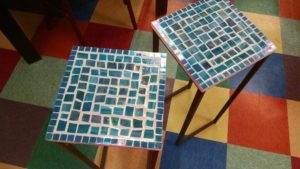 The exciting thing about mosaic work is the dramatic reveal. After all the grout has been filled my pieces looked quite the mess. Basically as though I had just smeared frosting all over my tables. My favorite part came next: cleaning off the tiles and smoothing the grout to reveal the sparkling finished project!
The exciting thing about mosaic work is the dramatic reveal. After all the grout has been filled my pieces looked quite the mess. Basically as though I had just smeared frosting all over my tables. My favorite part came next: cleaning off the tiles and smoothing the grout to reveal the sparkling finished project!
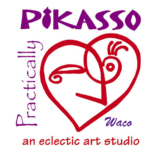 Practically Pikasso is the only art space of its kind here in Waco and offers a much wider selection of items than many other studios in cities around Central Texas. Whether you’re looking for a fresh option to get together with friends, or you need a creative place to refresh on your own, check out what Practically Pikasso has to offer. They have a selection of Valentine’s Day themed pieces available this month just for you!
Practically Pikasso is the only art space of its kind here in Waco and offers a much wider selection of items than many other studios in cities around Central Texas. Whether you’re looking for a fresh option to get together with friends, or you need a creative place to refresh on your own, check out what Practically Pikasso has to offer. They have a selection of Valentine’s Day themed pieces available this month just for you!
- Summer Kamp Classes for ages 6 and older: consider sending your creative ones to Kamp at Practically Pikasso this summer! With 8 sessions to choose from with different themes, there is sure to be something for everyone.
- Mosaic Mondays: enjoy 10% off all mosaic projects every Monday
- Tuesday Fuseday: enjoy 10% off all glass fusing projects every Tuesday
- Wednesday Ladies Night: ladies enjoy $2 off regular studio fees all Wednesday night
- Open Weekends! not free during the weekday? Come hang out on a Saturday or Sunday afternoon. Enjoy the music, and create something wonderful!
 Jenuine Poetess is an artist, visionary, and community organizer. In 2010, she founded In the Words of Womyn (ITWOW), an international, grass-roots, written and spoken-word arts project with chapters throughout Los Angeles, CA; Waco, TX; and Lebanon. Jenuine is the founder of Waco Poets Society and co-founder of the Central Texas Artist Collective. She writes, organizes, and creates rooted in the fierce conviction that holding intentional space, access, and opportunity for all people to foster their creative health is a matter of justice and is a vital asset to the sustainable thriving of communities. She currently lives and poems in Central Texas where she enjoys finding new ways to disrupt the homeostasis of her city. You can contact her at: j[email protected].
Jenuine Poetess is an artist, visionary, and community organizer. In 2010, she founded In the Words of Womyn (ITWOW), an international, grass-roots, written and spoken-word arts project with chapters throughout Los Angeles, CA; Waco, TX; and Lebanon. Jenuine is the founder of Waco Poets Society and co-founder of the Central Texas Artist Collective. She writes, organizes, and creates rooted in the fierce conviction that holding intentional space, access, and opportunity for all people to foster their creative health is a matter of justice and is a vital asset to the sustainable thriving of communities. She currently lives and poems in Central Texas where she enjoys finding new ways to disrupt the homeostasis of her city. You can contact her at: j[email protected].
The Act Locally Waco blog publishes posts with a connection to these aspirations for Waco. If you are interested in writing for the Act Locally Waco Blog, please email [email protected] for more information.
by Natalie James
About Project Link
Three years ago, the Bernard and Audre Rapoport Foundation, under the leadership of Executive Director Tom Stanton, began exploring ways to increase the rate of post-secondary success for Waco-area high school and college students. Over the course of many months, a group of about 40 individuals from local school districts and colleges (including school counselors, administrators, superintendents, and college presidents) assembled to discuss the challenges and barriers their students faced with college readiness, high school transition to college, and college success.
The result? After much collaboration and continued conversations, the group proposed to increase the number of counselors available to students at both the high school and college level so that students could receive consistent support for post-secondary success from ninth grade all the way through college or technical certification. This additional counseling would provide the “link” between success in high school and success in post-secondary studies.
In January 2015, The Bernard and Audre Rapoport Foundation Board approved the grant proposal for Project Link in the amount of $1,020,000. Prosper Waco serves as Project Link’s “backbone organization.” They work with the multiple organizations involved in the grant to provide oversight of the project’s implementation, including collecting data, tracking outcomes, and reporting to the Rapoport Foundation.
Project Link officially launched this past fall to help students from La Vega High School, University High School, McLennan Community College and Texas State Technical College. The project link team consists of one Project Link Coordinator, three Project Link High School Liaisons, and one Project Link Outreach Specialist. The Project Link Coordinator serves as the team’s lead and manages grant operations on a day-to-day basis. Three Project Link Liaisons, one at La Vega High School and two at University High School, work with students in the ninth through twelfth grade to prepare for college and workforce opportunities. The Project Link Coordinator and Outreach Specialist work together with the high school Liaisons to ensure a smooth transition to college and to provide continued support for Project Link students at the college level. Our team includes me as the Project Link Coordinator at McLennan Community College; Brandon Chappell, Project Link Outreach Specialist at Texas State Technical College; LaTishia Watson, Project Link Liaison at La Vega High School; and Marlayna Botello and Brittany Davis, Project Link Liaisons at University High School.
So what exactly do we do?
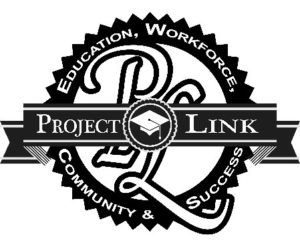 The goal of Project Link is to help students and their families chart a more assured and successful post-secondary journey. To accomplish this, Project Link participants develop personal relationships with professionals who provide intense one-on-one college, career, and financial advising and mentoring.
The goal of Project Link is to help students and their families chart a more assured and successful post-secondary journey. To accomplish this, Project Link participants develop personal relationships with professionals who provide intense one-on-one college, career, and financial advising and mentoring.
Really…who wouldn’t like having someone they can go to when they are unsure of what their next step is or when they need reassurance that they are on the right track? At both the high school and college level, Project Link provides academic and college support as well as personal and life coaching.
At the high schools, the Project Link team works to create a college-going culture by developing an environment that recognizes the value of higher education, by building awareness of post-secondary resources, and by nurturing student’s individual college and career aspirations. The participating high schools each have a dedicated space where the student can come to learn, explore, and begin to outline their own college and career path with the appropriate support and guidance to do so. Through one-on-one meetings and group sessions, the high school Liaisons help students with planning for optimum college and career readiness. They help students determine their career and college goals, think about enrichment and extracurricular engagement, figure out how to afford college and manage their money, navigate the application and registration process, prepare for SAT/ACT/TSI tests, and transition from their high school to the college of their choice. We encourage and support students as they explore and find a college that best meets their academic and career goals, and their personal needs – their true college match.
Project Link students participate in college and career nights, college application fairs, financial aid and scholarship application workshops, college tours, career days, and more. The students work on building their own educational resume by developing strong academic competencies and by participating in leadership and community service opportunities. College representatives from MCC, TSTC, and Baylor provide site visits for one-on-one advising for students who are considering attending one of these local post-secondary institutions.
Project Link is not designed to recruit specifically for MCC or TSTC, but statistically we know that many of our students for various reasons end up matriculating to one of those, so we provide additional support at those two schools.
At the college level, the Project Link Outreach Specialists provide one-on-one advising, life coaching, and other services. Students have the opportunity to participate in workshops that cover topics such as academic skills and support, careers, degrees, employability, life skills, personal wellness, computer and technology skills, and financial literacy and resources. Participants have additional opportunities to build their educational resume through community service, leadership, and internship opportunities. The goal of all of this is to help students develop the needed academic competencies, life skills, and strategies to attain their personal goals like earning their college degree, landing the job of their dreams, and achieving lifelong success.
Overall, Project Link helps to increase awareness, access and success for college readiness and retention. While building long lasting growth-oriented relationships with our students, the program allows each student to not only dream, but to make those dreams come true. At the end of the day, our program is not designed to do things for them, but instead to provide them with guidance and understanding about what steps they can make next in reaching their own dream, their own success. We can provide each of these students with all the knowledge, insight and information we have about pursuing a college or workforce degree that will land them the job of their dreams, but in the end, ultimately, we will not be the ones who will make these students successful. THEY WILL. Their persistence and hard work will be what takes them to their desired level of success. We are just serving as a beacon of light, showing them that with an advanced EDUCATION, comes great WORKFORCE and career opportunities that will lead them to be more productive members of our society and COMMUNITY. I would say that is a win, a victory, a SUCCESS for us all.
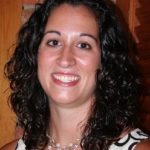 Natalie James is the Coordinator for Project Link. A native of the Waco area, she has proudly worked in Higher Education for the past 10 years at McLennan Community College. She earned her AA degree from MCC, a BSAS degree from Tarleton State University through the MCC University Center, and M.Ed. from Angelo State University. She is also a proud wife and mother to two amazing daughters. If you have questions about Project Link, feel free to contact Natalie at [email protected] or at 254-299-8517.
Natalie James is the Coordinator for Project Link. A native of the Waco area, she has proudly worked in Higher Education for the past 10 years at McLennan Community College. She earned her AA degree from MCC, a BSAS degree from Tarleton State University through the MCC University Center, and M.Ed. from Angelo State University. She is also a proud wife and mother to two amazing daughters. If you have questions about Project Link, feel free to contact Natalie at [email protected] or at 254-299-8517.
by Christina Helmick
The start of a new year means starting new things, right? Prosper Waco is starting the new year by working on collaborative and partner-led projects, supporting and facilitating collaborative grant applications, and engaging the community each step of the way. The projects the Prosper Waco backbone and community partners are working on address the goals of the initiative’s common agenda.
What are the specific projects?
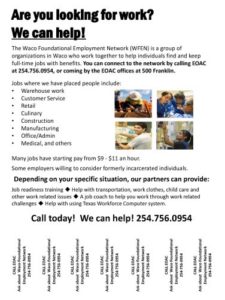 There are numerous collaborative projects the Prosper Waco backbone and community partners are currently working on, such as the Waco Foundational Employment Network, Community Health Worker program and Project Link. Skillpoint Alliance and Family Health Center Advanced Care Management are two partner-led projects we are currently working on.
There are numerous collaborative projects the Prosper Waco backbone and community partners are currently working on, such as the Waco Foundational Employment Network, Community Health Worker program and Project Link. Skillpoint Alliance and Family Health Center Advanced Care Management are two partner-led projects we are currently working on.
As the backbone organization, we are currently supporting and facilitating two collaborative grant applications, which are the System of Care grant and the HOPES grant. Supporting the application process of these grants is an effort to capture resources for our entire Waco community.
Each project advances the common agenda of the Prosper Waco initiative and has been reviewed and discussed by Prosper Waco working groups and steering committees.
How can I learn more about the projects?
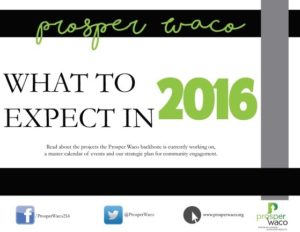 We’ve created a “What To Expect In 2016” report for you to download to learn more about the projects the Prosper Waco backbone organization and community partners are currently working on. As an extra bonus, we’ve included in the report a master calendar of events for 2016 and Prosper Waco’s strategic plan for community engagement.
We’ve created a “What To Expect In 2016” report for you to download to learn more about the projects the Prosper Waco backbone organization and community partners are currently working on. As an extra bonus, we’ve included in the report a master calendar of events for 2016 and Prosper Waco’s strategic plan for community engagement.
Download the report and contact us with your feedback, questions or comments. You can contact us by calling 254-741-0081 or sending an email to [email protected].
How can I become involved in the Prosper Waco initiative in 2016?
There are multiple ways you can become involved in the Prosper Waco initiative. Here is a list of a few ways you can become involved:
Volunteer: There are various opportunities for you to volunteer in our community, from one-time events to weekly opportunities. Volunteer opportunities range from mentoring youth in Waco to facilitating financial literacy education classes with job training programs. Check out the Get Involved tab on our website to learn more.
Connect: The Prosper Waco Community Engagement Council wants to connect with YOU! If you are interested in having your voice heard, helping guide the work of the initiative, and want to know who you can reach out to in your neighborhood for information regarding the initiative, email [email protected] and a community engagement council member from your neighborhood will contact you.
Attend: Our working group and steering committees are open to all community members. Visit the events tab on our website to learn about the meeting times, dates and locations. Don’t worry if you can’t make the meetings-we take notes at every meeting and would be happy to send them your way!
Subscribe: Subscribe to our monthly newsletter and stay abreast of the Prosper Waco initiative.
We know there isn’t a silver bullet to addressing the poverty issues in our community, but with the community voice guiding the work and the hard work of our community partners, collectively we can make Waco the best community it can be.
Contact us! Call us at 254-741-0081 or send an email to [email protected].
 Christina Helmick is the director of communication at Prosper Waco. She is a recent graduate of Baylor University with a BA in Journalism, Public Relations & New Media. Originally she is from Washington, D.C., but has stayed in Waco post-graduation. She is an active mentor at J.H. Hines Elementary School, enjoys spending time with her family and watching Baylor football. Sic ’em Bears!
Christina Helmick is the director of communication at Prosper Waco. She is a recent graduate of Baylor University with a BA in Journalism, Public Relations & New Media. Originally she is from Washington, D.C., but has stayed in Waco post-graduation. She is an active mentor at J.H. Hines Elementary School, enjoys spending time with her family and watching Baylor football. Sic ’em Bears!
The Act Locally Waco blog publishes posts with a connection to these aspirations for Waco. If you are interested in writing for the Act Locally Waco Blog, please email [email protected] for more information.
By Crystal Hernandez
Arthritis pain can be excruciating – it doesn’t have to be. We can help through EnhanceFitness®.
According to the Centers for Disease Control and Prevention, physical activity can reduce pain; improve function and emotional well-being in those suffering from arthritis. Programs, such as EnhanceFitness, have been approved by the CDC to help those with the disease.
EnhanceFitness is a 16-week program that meets three times each week. The curriculum helps participants to improve cardiovascular function, muscular strength and endurance, balance, range of motion and flexibility.
Instructors are able to work with all levels and abilities because both the cardiovascular and resistance training can be performed seated or standing. To alleviate the need to grasp weights with hands and fingers, which can be difficult and painful, wrist and ankle cuffs are used. These secure around the limbs and as the participant becomes stronger they can gradually increase the weight by ½ pound increments.
Assessments are performed at the start of the program and again at the end of the 16-week program. This allows participants to see the improvements that they’ve made in their fitness.
EnhanceFitness classes require registration and can hold 15-25 participants. Classes are held at both the Doris Miller Family YMCA and the Waco Family YMCA. It is free to YMCA members. For non-members it is $100 for the full 16 weeks. The next program will begin on April 4. For more information, contact Chronic Disease Prevention Specialist, Crystal Hernandez at 254-776-6612 or [email protected] .
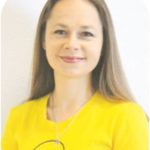 This Act Locally Waco blog post was written by Crystal Hernandez. Crystal is the Chronic Disease Specialist for the Waco Family YMCA. She received her degree in Exercise Science and Health Promotion from the University of Memphis. She and husband Shawn are blessed to be the parents of 4 beautiful children. In her free time, she loves hitting the pavement and pounding out a good run.
This Act Locally Waco blog post was written by Crystal Hernandez. Crystal is the Chronic Disease Specialist for the Waco Family YMCA. She received her degree in Exercise Science and Health Promotion from the University of Memphis. She and husband Shawn are blessed to be the parents of 4 beautiful children. In her free time, she loves hitting the pavement and pounding out a good run.
The Act Locally Waco blog publishes posts with a connection to these aspirations for Waco. If you are interested in writing for the Act Locally Waco Blog, please email [email protected] for more information.
By Meilana Charles
The Super Bowl is America’s most watched national sporting event. On Super Bowl 50 Sunday, Feb. 7, 2016, there will be lots of game day socializing that may include drinking. That’s why the Cooperative Extension Program of Prairie View A&M University and Texas A&M AgriLife Extension Service “Watch UR BAC” program is urging football fans to call the play now: Drinking OR driving. If you plan on drinking on Super Bowl Sunday, designate a sober driver to get you home safely.
“Drunk driving is completely preventable,” said Texas A&M AgriLife Extension Service agent Colleen Follen “All it takes is a little planning. We want fans to remember that it’s a choice — drink or drive, but never do both. Law enforcement agencies will be out in large numbers to stop anyone who makes the dangerous decision to drive impaired.”
According to the Texas Department of Transportation, 1,041 people were killed in drunk-driving crashes in 2014, accounting for 29 percent of the total motor vehicle traffic fatalities in Texas. Super Bowl Sunday is a risky day for drunk-driving crashes.The “Watch UR BAC” program advises that if you’re attending a Super Bowl party or watching the game at a sports bar or restaurant:
- Designate your sober driver, or plan another way to get home safely before the party begins.
- If you don’t have a designated driver, then ask a sober friend for a ride home; or call a cab, friend or relative to come and get you. If you are at a friend’s house, stay the night.
- Never let friends drive if they have had too much to drink.
If you’re hosting a Super Bowl party:
- Make sure all your guests have a non-drinking driver to take them home, or arrange for alternate transportation to see that they get home safely.
- Serve plenty of food and non-alcoholic drinks at the party.
- Host your party just like they do at the stadium. Stop serving alcohol at the end of the third quarter of the game, and begin serving coffee and dessert.
- Take the keys away from anyone who has had too much to drink.
- Remember, you can be held liable and prosecuted if someone you served ends up in a drunk- driving crash.
Cooperative Extension Program of Prairie View A&M University and Texas A&M AgriLife Extension Service’s Watch UR BAC program is a free, statewide program to promote alcohol awareness, the dangers of impaired driving, and friends watching out for friends. Contact [email protected] for booking information.
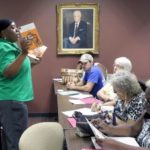 This Act Locally Waco blog post was written by Meilana Charles. Meilana is a Family and Consumer Sciences Extension Agent at Cooperative Extension Program at Prairie View A&M University. Meilana’s priority areas for providing educational resources to McLennan County are general nutrition, money management and parenting. She has a M.S. in Child Development from Texas Woman’s University and is a certified Human Development and Family Studies professional through American Association of Family and Consumer Sciences.
This Act Locally Waco blog post was written by Meilana Charles. Meilana is a Family and Consumer Sciences Extension Agent at Cooperative Extension Program at Prairie View A&M University. Meilana’s priority areas for providing educational resources to McLennan County are general nutrition, money management and parenting. She has a M.S. in Child Development from Texas Woman’s University and is a certified Human Development and Family Studies professional through American Association of Family and Consumer Sciences.
The Act Locally Waco blog publishes posts with a connection to these aspirations for Waco. If you are interested in writing for the Act Locally Waco Blog, please email [email protected] for more information.
By Amy Jimenez
His smile was unlike other smiles teenagers wear. It screamed bravery and courage, masking the pain and loneliness I could clearly hear behind his words. That day, he showed up to school. We celebrated his step forward. One step toward his goal of graduating was worth celebrating. The dream of graduation is easily clouded when your report card shows half the credits you need to walk across the stage. However, this smile showed the determination of fulfilling a mother’s dream, a dream passed on to a son who painfully works through her loss every day. His smile can get lost in the labels and numbers I see in the literature, headlines, and records. Unaccompanied. Homeless. Food Insecure. At Risk. Instead, his smile should represent a dreamer—his dreams of travel, of college, of somehow experiencing hope again.
Teenagers just like this student bring me to a place of humility, of wanting more for them, and dreaming big dreams alongside them. My heart for high school kids led me to work with Waco ISD Homeless Outreach for the past two years, a phenomenal department that works with families and high school students who are homeless as defined by the McKinney-Vento Act. Unaccompanied homeless youth (UHY) are students who experience homelessness and are not in custody of a parent or legal guardian. Right away I learned about the extensive issues homeless high schools students face, including risk of dropping out, family conflict and violence, low self-esteem, sex trafficking, and other deep wounds.
- In the U.S., 1.6 million youth experience homelessness.
- 20-40% of unaccompanied homeless youth were abused sexually in their homes
- 40-60% of UHY were abused physically
- 20-40% of UHY have been thrown out of their homes because they are gay, lesbian, bisexual, transgender, or pregnant.[1]
Many of our students don’t realize they are homeless. To them, staying at a motel or sleeping on a couch or in a car is just life and they are fighting to keep up with their school work and jobs. Their stories are really tough to hear, but it’s a privilege when they bravely share them. Stories I’ve heard from our students in Waco range from unsafe living conditions, abusive relationships, couch surfing, incarcerated parents, and aging out of a life in foster care. Some students have confided being kicked out because of whom they love. The calls that really punch your gut are ones from our partners at UnBound, who prevent and intervene when girls have been trafficked. Hearing that students from Waco High and University High have been rescued from a trafficker will never get easier, but it sure ignites a desire to find ways to care for them and prevent it from happening again. These stories are also filled with winning medals at track meets, making the top 10% of their class, reuniting with mom, receiving a scholarship from Mary-Hardin Baylor, and walking across the stage at graduation. On paper, we call them “Unaccompanied Homeless Youth”. But when you get to know them, you instead begin to see them as resilient, persistent, tenacious, and brilliant.
 The Cove began as a dream of Cheryl Pooler’s six years ago after hearing the stories of homeless families in Waco ISD. With over 1,300 homeless students, Cheryl, Waco ISD’s Homeless Liaison, has meticulously fought for each student and their families to have access to resources and dignity throughout their education in Waco ISD. Cheryl and I share a soft spot in our hearts for high school students. When you have the privilege of meeting a high school student who is experiencing homelessness, you’ll never forget his or her story.
The Cove began as a dream of Cheryl Pooler’s six years ago after hearing the stories of homeless families in Waco ISD. With over 1,300 homeless students, Cheryl, Waco ISD’s Homeless Liaison, has meticulously fought for each student and their families to have access to resources and dignity throughout their education in Waco ISD. Cheryl and I share a soft spot in our hearts for high school students. When you have the privilege of meeting a high school student who is experiencing homelessness, you’ll never forget his or her story.
Cheryl has shared the vision for a safe place for students to come after school where they could feel valued, cared for, and loved. In order to prevent chronic homelessness, research points to creating an empowering space that offers not only a place to shower and do laundry before finding a temporary place to sleep, but one where students can receive counseling and medical screenings, meet with an adult who can walk through life with them, make a connection to a job training program, and involve youth in the planning and leadership. The Cove’s Student Advisory Committee is made up of both teenagers and young adults who have experienced homelessness, and their input has been invaluable as the Cove is being formed.
But today the Cove is not just a dream. It is becoming a reality. I have felt so humbled at the response from the Waco community. Waco has rallied around the issue of youth homelessness and has been welcoming and supportive of starting the Cove. The Cove is not just one organization. It’s truly a community effort to love, care for, and empower the most vulnerable youth in our city.
Hopefully to open this spring of 2016, the Cove will be an after school nurturing center for the over 60 unaccompanied homeless youth in our district. At the Cove, students will have access to tutoring, a computer lab, family style dinners, counseling services, medical screenings, haircuts, space to recharge, and maybe even play basketball. Our high school students themselves have contributed greatly to this process of developing the Cove along the way. Their insight and experience is the greatest we have to truly care for and end youth homelessness in our city.
As a local Wacoan, I am so excited for a Waco where former students from the Cove are the nurses who care for our families, the real estate agents who help purchase our houses, the head caterers at our local weddings, the teachers changing the lives of our kids, and the mayors who continue the legacy of bringing positive, collective change to the place we call home.
If you’d like to get involved, we’d love for you to join us in the adventure. Please feel free to email [email protected]. You can also visit our Facebook page or find us at www.thecovewaco.org
 Amy Jimenez has been a Wacoan since 2009 after moving from Cincinnati, Ohio. She graduated from Baylor in 2012 with a degree in International Studies. She has interned with Waco ISD Homeless Outreach, the Cove, and also works for the Texas Hunger Initiative. She will be graduating with her Master of Social Work this May from the Diana R. Garland School of Social Work. Amy adores her best friend and husband, Blake, her dog, Marsha, and is passionate about seeking justice and loving people well here in Waco. Feel free to contact Amy at [email protected] or (254) 300-8443.
Amy Jimenez has been a Wacoan since 2009 after moving from Cincinnati, Ohio. She graduated from Baylor in 2012 with a degree in International Studies. She has interned with Waco ISD Homeless Outreach, the Cove, and also works for the Texas Hunger Initiative. She will be graduating with her Master of Social Work this May from the Diana R. Garland School of Social Work. Amy adores her best friend and husband, Blake, her dog, Marsha, and is passionate about seeking justice and loving people well here in Waco. Feel free to contact Amy at [email protected] or (254) 300-8443.
The Act Locally Waco blog publishes posts with a connection to these Aspirations for Waco. If you are interested in writing for the Act Locally Waco Blog, please email [email protected] for more information.
[1] National Association for the Education of Homeless Children and Youth. (n.d.). Unaccompanied Homeless Youth. Retrieved from www.naehcy.org/educational-resources/youth
By Diego Loredo
It’s a new year and for college students a new semester! That means it’s time for relentless classes, long nights of studying, and who knows what else. For me, this is my fourth semester at UNT and I’m preparing myself for another long semester.
My spring semester is looking pretty good so far. I’m taking four classes for my major, public relations, and one foreign language class (Japanese). All of my classes are after 10 so that means I don’t have to wake up too early since I don’t have any 8 am classes anymore. Also, on Thursdays and Fridays I only have one class so that makes it easier for me. I only see myself having a problem in maybe two classes; this semester should be a good opportunity to get my GPA back up.
Now it’s time to get down to business. Going into my fourth semester, I’m getting more and more accustomed to college. Because of that, I’ve developed a few ways on how to start the semester off right. Everyone has their own way of beginning the semester but hopefully these will be helpful to any college student.
Buy a calendar!
Buying a calendar for school has become a habit of mine. You can buy a regular calendar or, like me, buy a dry-erase calendar so you can easily write/erase things. Having a calendar can help you keep track of things and make sure you don’t fall behind in any of your classes. What I do is write everything that I have to do that month so that I know exactly what is due and what I still have to time to do. A calendar is an irreplaceable, and cheap, college investment.
Introduce yourself to your classmates
I’ve said this before and I’m going to say it again. Introduce yourself to your classmates! At the end of each class, introduce yourself to a few classmates so that you have someone to go to in case you’re having trouble in that class. Or maybe you’ll be lucky enough to have a class with some friends. Having someone you can go to for help in a class will be your most valuable asset.
Dedicate a few hours a day to studying
This is hard for me to do, but it’s something I’m trying to get myself to do more. It doesn’t have to take up half your day, but dedicate maybe two or three hours a day to studying. It can even be just an hour, as long as you’re using a part of your day to get ahead in one of your classes. Another thing I do is dedicate a day during the weekend to study and catch up on my classes, then spend the night hanging out with friends. I’m not saying study every day after class, but make a schedule of when you’ll study for each class to make sure you get things done.
I know college can be stressful and not fun at all sometimes. But all it takes to make college enjoyable is to have a plan ready. Once you make that plan and stick to it, it can completely turn around your semester. If you stick to these three things, then I’m sure it’ll make your semester much easier. I’m looking forward to what this semester has in store for me and will do everything I can to make it as enjoyable as possible.
 Diego Loredo is a sophomore at the University of North Texas. He is majoring in public relations. He graduated from University High School in 2014. Although he is still not quite sure what exactly he wants to do, he thinks he wants to work somewhere in sports PR (preferably soccer or college football). His hobbies include playing soccer and golf. He is 19 years old.
Diego Loredo is a sophomore at the University of North Texas. He is majoring in public relations. He graduated from University High School in 2014. Although he is still not quite sure what exactly he wants to do, he thinks he wants to work somewhere in sports PR (preferably soccer or college football). His hobbies include playing soccer and golf. He is 19 years old.
The Act Locally Waco blog publishes posts with a connection to these Aspirations for Waco. If you are interested in writing for the Act Locally Waco Blog, please email [email protected] for more information.
(Note: This is Part 5 in a series on Pay Day lending and its effect on our Waco community. For the rest of the series, click here: Pay Day Lending in Waco. — ABT)
By Shannon Kendrick-Wittmer,
To many people, Goodwill is synonymous with thrift store, a place to find discounted clothing, furniture, or other treasures discarded by someone looking to declutter their house or make room in their closet. What most individuals don’t realize is that by donating gently used items or shopping at a Goodwill retail store, people are helping Goodwill achieve their primary mission: putting people to work. The money spent on purchases at Goodwill stays in the local community and is used to fund various employment, education, and training programs to help individuals get a job, improve their skills, and become self-sufficient. Heart of Texas Goodwill’s Learning Center services focus on job attainment, job retention, and skills building. Participants can get help improving their interview skills techniques, creating a resume, searching for a job or they can attend one of our many classes, such as Microsoft Word and Excel, GED, ESL, Parenting, and Anger Management.
While helping people gain the skills necessary to land a job is our main mission, we also recognize that we can’t help someone find a job without giving them the skills necessary to manage the money they earn. For many years, we have provided one-on-one budgeting services, financial literacy classes, and education on the pitfalls of using pay day lending, but we still encounter a large number of our participants who have fallen into debt because of the need to utilize pay day lenders for quick cash. This is a scenario playing out at many other social service agencies around Texas. At the state level, the 15 Goodwill agencies in Texas joined together, on numerous congressional years, to introduce bills that would enforce regulation of Pay Day lenders in Texas. Each time legislation was introduced, it was voted down.
Heart of Texas Goodwill, along with the other Goodwill’s in Texas, decided to focus efforts concerning pay day (predatory lending) at the local level. About this time the Citizens for Responsible Lending had their first meeting. It wasn’t long before we realized that our organization’s role could be to offer an alternative to pay day lending in the Waco area, in the form of the Community Loan Center.
There has been a lot of buzz in Waco lately about the Community Loan Center, who can utilize it, and how Goodwill is involved. Although it is still in its infancy in Waco, we foresee it as being a viable alternative to certain people needing access to cash quickly.
So what is the Community Loan Center (CLC)? The CLC Small Dollar Loan Program is an employer-based small dollar loan program administered through local nonprofits in Texas. The CLC recruits local employers to participate, at no cost, and the program is then marketed to the employer’s employees. Employees who participate are able to borrow up to $1,000 at 18% interest with up to 12 months to repay the loan. Employees can apply for the loan using an online portal and once approved, the funds are wired into their personal bank accounts. Repayment of the loan is done through payroll deduction, set up by the employer.
What is Goodwill’s role in the CLC? Heart of Texas Goodwill has committed to being the non-profit administrator of the Community Loan Center. As the administrator of the CLC, we will be responsible for recruiting area employers to sign up for the program, assisting those employers in marketing the program to their employees, and raising funds to be used as capital for the loans made to employees. Heart of Texas Goodwill Industries made the decision to create a separate 501c3 corporation for the new company, which will be named the Community Loan Center of the Heart of Texas. A board of directors have been appointed to govern this corporation and administrative duties will be handled by existing staff employed by Goodwill.
Where does the money come from to issue loans? The loan capital used by the CLC can come from a variety of sources, such as grants, investors, or low interest loans from banks. Heart of Texas Goodwill Industries, along with other community members, will be working continuously to seek funding sources for the capital pool. As the funds increase, more employers can be added to the program, therefore increasing the number of employees with access to the small dollar, low interest loans.
Why is the interest rate 18%? This may seem high to some people but it very modest in comparison to the 400%-600% charged by pay day lenders for similar loans. The 18% interest fee covers various items such as: administrative costs to run the program, defaulted loans, and interest payments for loans used in the capital pool. This interest rate also helps to increase the amount of money available in the capital pool.
Who can take part in the program? Only employees working for employers who have signed up for the program are eligible to take a small dollar loan through the Community Loan Center of the Heart of Texas. Currently, in the Waco area, the only employers enrolled in the program are the City of Waco and Waco ISD. Employees working for these entities may take a small dollar loan. At this time there is only enough money in the capital pool to cover these two employers. When we have more money in the capital pool, we can add more employers.
The Community Loan Center of the Heart of Texas will not eradicate pay day lenders all together, but we strongly believe it is a step in the right direction toward a more financially secure community. It provides people who need a small loan quickly an alternative to payday lending. We hope to see the program grow in the future to include many more employers. To that end we welcome the help of anyone in the community wanting to assist us in fundraising, which will be a key factor in growing the CLC in Waco. Anyone with questions about the Community Loan Center may contact me at the Goodwill Corporate Headquarters in Waco at 254-753-7337.
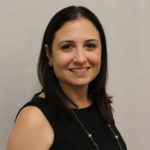 Shannon Kendrick-Wittmer is the Vice President of Mission and Workforce Advancement at Heart of Texas Goodwill Industries. She has a BA in Psychology from Baylor University and a Master’s in Business Administration from Tarleton State University. She has lived in Waco for the past 15 years, worked at Goodwill for 11 years, and has been married for a year and a half to Jonathon Wittmer, a field engineer with TYMCO.
Shannon Kendrick-Wittmer is the Vice President of Mission and Workforce Advancement at Heart of Texas Goodwill Industries. She has a BA in Psychology from Baylor University and a Master’s in Business Administration from Tarleton State University. She has lived in Waco for the past 15 years, worked at Goodwill for 11 years, and has been married for a year and a half to Jonathon Wittmer, a field engineer with TYMCO.
The Act Locally Waco blog publishes posts with a connection to these Aspirations for Waco. If you are interested in writing for the Act Locally Waco Blog, please email [email protected] for more information.
